公司理财英文版第二章
- 格式:ppt
- 大小:2.06 MB
- 文档页数:50
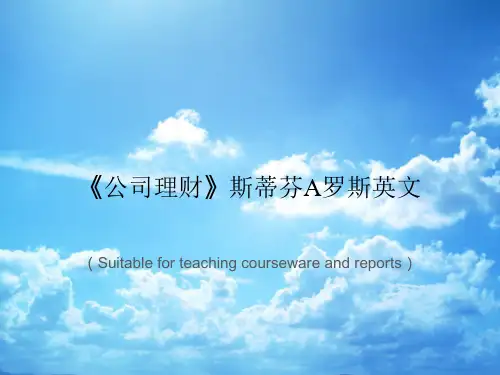
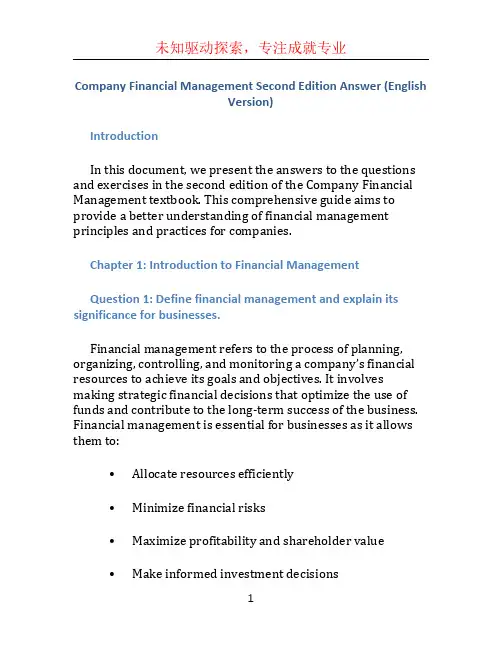
Company Financial Management Second Edition Answer (EnglishVersion)IntroductionIn this document, we present the answers to the questions and exercises in the second edition of the Company Financial Management textbook. This comprehensive guide aims to provide a better understanding of financial management principles and practices for companies.Chapter 1: Introduction to Financial ManagementQuestion 1: Define financial management and explain its significance for businesses.Financial management refers to the process of planning, organizing, controlling, and monitoring a company’s financial resources to achieve its goals and objectives. It involves making strategic financial decisions that optimize the use of funds and contribute to the long-term success of the business. Financial management is essential for businesses as it allows them to:•Allocate resources efficiently•Minimize financial risks•Maximize profitability and shareholder value•Make informed investment decisions•Ensure regulatory complianceQuestion 2: Describe the three primary areas of financial management.The three primary areas of financial management are:1.Capital Budgeting: This involves evaluating andselecting the best long-term investment opportunities that align with the company’s goa ls. It includes analyzing thepotential returns, risks, and cash flows associated with each investment project.2.Capital Structure: Capital structure refers to themix of debt and equity used to finance a company’soperations. Financial managers need to determine theoptimal capital structure that balances the cost of capitaland the risk of the business. This decision affects thecompany’s ability to raise funds and its overall financialstability.3.Working Capital Management: Working capitalmanagement focu ses on managing the company’s short-term assets and liabilities to ensure smooth businessoperations. It includes managing cash flow, inventory,accounts receivable, and accounts payable effectively tomaintain a healthy liquidity position.Question 3: Explain the goal of financial management.The goal of financial management is to maximize shareholder wealth or value. Financial managers aim to make decisions that increase the market value of the company’sshares and generate higher returns for shareholders. This objective is accomplished by making sound financial decisions, such as investing in profitable projects, optimizing the capital structure, and efficiently managing working capital.Chapter 2: Financial Statements and AnalysisExercise 1: Analyzing Financial StatementsUsing the financial statements for Company XYZ provided below, answer the following questions:Income Statement:Year 1Year 2Revenue$500,000$600,000Expenses$300,000$350,000Net Income$200,000$250,000Balance Sheet:Year 1Year 2Assets$800,000$900,000Liabilities$200,000$250,000Equity$600,000$650,000a)Calculate the net profit margin for Year 1 and Year 2.Solution:Net Profit Margin (Year 1) = Net Income (Year 1) / Revenue (Year 1) * 100 = $200,000 / $500,000 * 100 = 40%Net Profit Margin (Year 2) = Net Income (Year 2) / Revenue (Year 2) * 100 = $250,000 / $600,000 * 100 = 41.67%b)Determine the return on equity (ROE) for Year 1 andYear 2.Solution:Return on Equity (Year 1) = Net Income (Year 1) / Equity (Year 1) * 100 = $200,000 / $600,000 * 100 = 33.33%Return on Equity (Year 2) = Net Income (Year 2) / Equity (Year 2) * 100 = $250,000 / $650,000 * 100 = 38.46%c)Calculate the current ratio for Year 1 and Year 2.Solution:Current Ratio (Year 1) = Assets (Year 1) / Liabilities (Year 1) = $800,000 / $200,000 = 4Current Ratio (Year 2) = Assets (Year 2) / Liabilities (Year 2) = $900,000 / $250,000 = 3.6ConclusionIn this document, we provided the answers to selected questions and exercises from the second edition of the Company Financial Management textbook. These answers should help readers enhance their understanding of financial management principles and practices for companies. It is important to note that this document covers only a fraction of the content presented in the textbook and can be used as a supplementary resource for further study.。

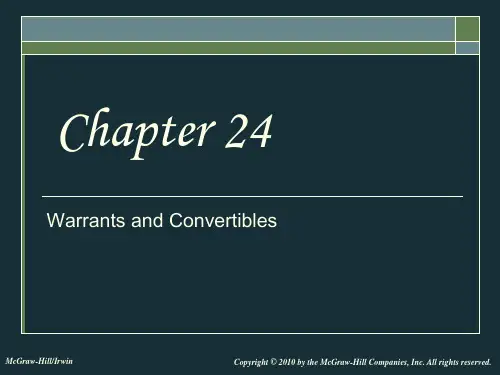
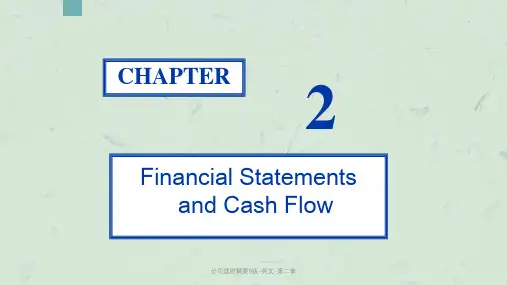
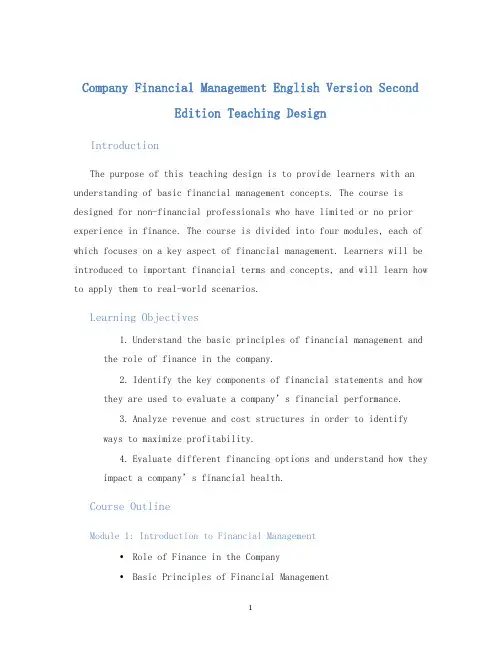
Company Financial Management English Version SecondEdition Teaching DesignIntroductionThe purpose of this teaching design is to provide learners with an understanding of basic financial management concepts. The course is designed for non-financial professionals who have limited or no prior experience in finance. The course is divided into four modules, each of which focuses on a key aspect of financial management. Learners will be introduced to important financial terms and concepts, and will learn how to apply them to real-world scenarios.Learning Objectives1.Understand the basic principles of financial management andthe role of finance in the company.2.Identify the key components of financial statements and howthey are used to evaluate a company’s financial performance.3.Analyze revenue and cost structures in order to identifyways to maximize profitability.4.Evaluate different financing options and understand how theyimpact a company’s financial health.Course OutlineModule 1: Introduction to Financial Management•Role of Finance in the Company•Basic Principles of Financial ManagementModule 2: Financial Statements•Balance Sheet•Income Statement•Cash Flow StatementModule 3: Profitability Analysis•Revenue Streams•Cost Structures•Break-Even AnalysisModule 4: Financing Options•Equity Financing•Debt Financing•Capital StructuringTeaching MethodologyThis course will primarily be delivered through a combination of lectures, case studies, and group discussions. Learners will be given supplemental reading materials and will be expected to actively participate in class discussions.AssessmentStudents will be assessed on their understanding of key concepts through the completion of assignments, quizzes, and a final exam. The final exam will be comprehensive and will cover material from all four modules.ConclusionAt the end of this course, learners will have a basic understanding of financial management and the role of finance in the company. They will be able to analyze financial statements, evaluate profitability, and understand different financing options. These skills will enable learners to make informed business decisions and contribute to their company’s financial success.。
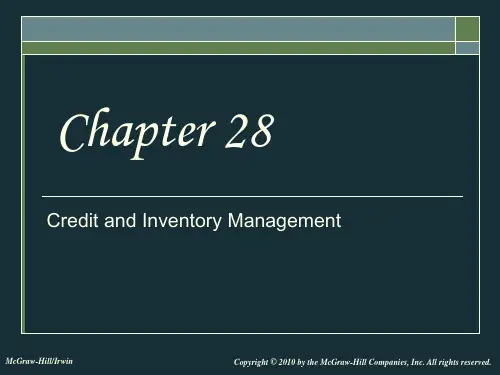
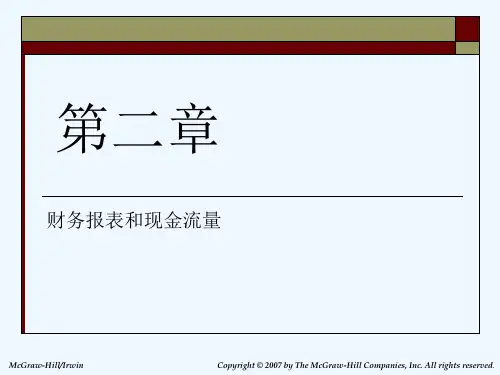
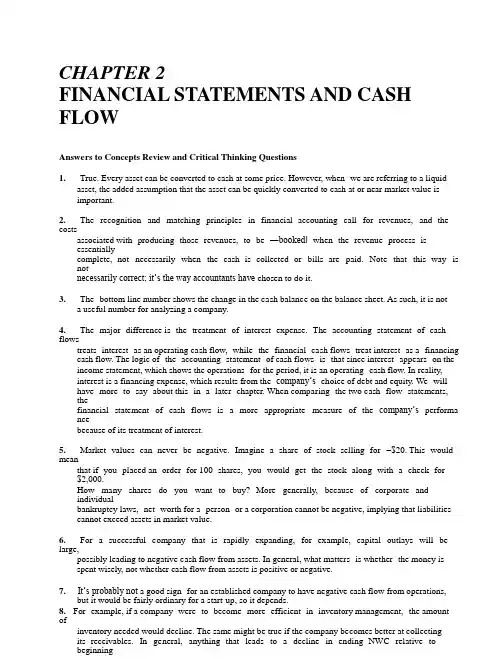
CHAPTER 2FINANCIAL STATEMENTS AND CASH FLOWAnswe rs to Concepts Review and Critical Thinking Questions1. True. Every asset can be converted to cash at some price. However, when we are referring to a liquidasset, the added assumption that the asset can be quickly converted to cash at or near market value is important.2. The recognition and matching principles in financial accounting call for revenues, and the costsassociated with producing those revenues, to be ―booked‖when the revenue process isessentiallycomplete, not necessarily when the cash is collected or bills are paid. Note that this way is notnecessarily correct; it‘s the way accountants have chosen to do it.3. The bottom line number shows the change in the ca sh balanc e on the balance sheet. As such, it is nota use ful number for analyzing a company.4. The major difference is the treatment of interest expense. The accounting statement of cash flowstreats interest as an operating ca sh flow, while the financial ca sh flows treat interest as a financing cash flow. The logic of the accounting statement of cash flows is that since interest appears on the income statement, which shows the operations for the period, it is an operating cash flow. In reality, interest is a financing expense, which results from the company‘s choice of debt and equity. We will have more to say about this in a later chapter. When compa ring the two c ash flow statements, thefinancial statement of cash flows is a more appropriate measure of the company‘s performa ncebecause of its treatment of interest.5. Market values can never be negative. Imagine a share of stock selling for –$20. This would meanthat if you placed an order for 100 shares, you would get the stock along with a check for $2,000.How ma ny shares do you want to buy? More generally, because of corpora te andindividualbankruptcy laws, net worth for a person or a corporation cannot be negative, implying that liabilities cannot exceed assets in market value.6. For a successful c ompany that is rapidly expanding, for example, capital outlays will be large,possibly leading to negative c ash flow from assets. In general, what matters is whether the money is spent wisely, not whe ther cash flow from assets is positive or negative.7. It‘s probably not a good sign for an e stablished company to have negative cash flow from operations,but it would be fairly ordinary for a start-up, so it depends.would have this effect. Negative net c apital spending would mea n more long-lived assets wereliquidated than purchased.49.10. If a company raises more money from selling stock than it pays in dividends in a particular period,its cash flow to stockholders will be negative. If a company borrows more than it pays in interest and principal, its cash flow to creditors will be negative.The adjustments discussed were purely accounting changes; they had no cash flow or market value consequences unless the new accounting information caused stockholders to revalue the derivatives.Solutions to Questions and Proble msNOTE: All end-of-chapter problems were solved using a spreadsheet. Many problems require multiplesteps. Due to space and readability constraints, when these intermediate steps are included in thissolutions manual, rounding may appear to have occurred. However, the final answer for each problem is found without rounding during any step in the problem.Basic1. To find owners‘ equity, we must construct a balance sheet as follows:Balance SheetCA $ 5,300 CL $ 3,900NFA 26,000 LTD 14,200OE ??TA $31,300 TL & OE $31,300We know that total liabilities and owners‘ equity (TL & OE) must equal total assets of $31,300. We also know that TL & OE is equal to current liabilities plus long-term debt plus owner‘s equity, soowner‘s equity is:OE = $31,300 –14,200 – 3,900 = $13,200NWC = CA – CL = $5,300 – 3,900 = $1,4002. The income statement for the company is:Income StatementSales $493,000Costs 210,000Depreciation 35,000EBIT $248,000Interest 19,000EBT $229,000Taxes 80,150Net income $148,8503.4.5.6. One equation for net income is:Net income = Dividends + Addition to retained earningsRearranging, we get:Addition to retained earnings = Net income – Divide ndsAddition to retained earnings = $148,850 – 50,000Addition to retained earnings = $98,850To find the book value of current assets, we use: NWC = CA – CL. Rearranging to solve for current assets, we get:CA = NWC + CL = $800,000 + 2,100,000 = $2,900,000The market value of current assets and net fixed assets is given, so:Book value CA= $2,900,000 Market value CA= $2,800,000Book value NFA = $5,000,000 Market value NFA= $6,300,000Book value assets = $7,900,000 Market value assets= $9,100,000Taxes = 0.15($50K) + 0.25($25K) + 0.34($25K) + 0.39($246K – 100K)Taxes = $79,190The average tax ra te is the total tax paid divided by net income, so:Average tax rate = $79,190 / $246,000Average tax rate = 32.19%The marginal tax rate is the tax rate on the next $1 of earnings, so the marginal tax ra te = 39%.To calculate OCF, we first need the income state ment:Income StatementSales $14,900Costs 5,800Depreciation 1,300EBIT $7,800Interest 780Taxable income $7,020Taxes 2,808Net income $4,212OCF = EBIT + Depreciation – TaxesOCF = $7,800 + 1,300 – 2,808OCF = $6,292Net capital spending = $1,730,000 – 1,650,000 + 284,000Net capital spending = $364,0007. The long-term debt account will increase by $10 million, the amount of the new long-term debt issue.Since the company sold 10 million new shares of stock with a $1 par value, the common stockaccount will increase by $10 million. The capital surplus account will increase by $33 million, thevalue of the new stoc k sold above its par value. Since the company had a net income of $9million,and pa id $2 million in dividends, the addition to retained earnings was $7 million, which willinc rease the accumulated retained earnings account. So, the new long-term debt a nd stockholders‘ equity portion of the balance sheet will be:Long-term debt $82,000,000Total long-term debt $82,000,000Shareholders equityPreferred stock $9,000,000Common stock ($1 par value) 30,000,000Ac cumulated retained earnings 104,000,000Capital surplus 76,000,000Total equity $ 219,000,000Total Liabilities & Equity $ 301,000,0008.9. Cash flow to creditors = Interest paid – Net new borrowingCash flow to creditors = $118,000 – ($1,390,000 – 1,340,000)Cash flow to creditors = $118,000 – 50,000Cash flow to creditors = $68,000Cash flow to stockholders = Dividends paid – Net new equityCash flow to stockholders = $385,000 – [(Common+ APIS) – (Common+ APIS)]end end beg beg10. Cash flow to stockholders = $385,000 – [($450,000 + 3,050,000) – ($430,000 + 2,600,000)] Cash flow to stockholders = $385,000 – ($3,500,000 – 3,030,000)Cash flow to stockholders = –$85,000Note, APIS is the additional paid-in surplus.Cash flow from assets= Cash flow to creditors + Cash flow to stockholders= $68,000 – 85,000= –$17,000Cash flow from assets= –$17,000 = OCF – Change in NWC – Net capital spending–$17,000 = OCF – (–$69,000) – 875,000Operating cash flowOperating cash flow= –$17,000 – 69,000 + 875,000= $789,000Cash flow to creditors = $118,000 – (LTD– LTD)11. a. IntermediateThe accounting statement of cash flows explains the change in cash during the year. Theaccounting statement of cash flows will be:Statement of cash flowsOperationsNet income $105Depreciation 90Changes in other current assets (55)Accounts payable (10)Total cash flow from operations $170Investing activitiesAcquisition of fixed assets $(140)Total cash flow from investing activities $(140)Financing activitiesProc eeds of long-term debt $30Dividends (45)Total cash flow from financing activities ($15)Change in cash (on balance sheet) $15b.Change in NWC= NWC e nd– NWC beg= (CA end–CL en d ) – (CA beg–CL be g)c.= [($50 + 155) – 85] – [($35 + 140) – 95)= $120 – 80= $40To find the cash flow generated by the firm‘s assets, we need the operating cash flow, and thecapital spending. So, calculating each of these, we find:Operating cash flowNet income $105Depreciation 90Operating cash flow $195Note that we can calculate OCF in this manner since there a re no taxes.Capital spendingEnding fixed assets Beginning fixed assets DepreciationCapital spending $340 (290)90 $140Now we c an calculate the cash flow gene rated by the firm‘s assets, which is: Cash flow from assetsOperating cash flow Capital spending Change in NWC Cash flow from assets $195 (140) (40) $1512. With the information provided, the cash flows from the firm are the capital spending and the changein net working capital, so:Cash flows from the firmCapital spending $(15,000)Additions to NWC (1,500)Cash flows from the firm $(16,500)And the cash flows to the investors of the firm are:Cash flows to investors of the firmSale of long-term debt (19,000)Sale of common stock (3,000)Dividends paid 19,500Cash flows to investors of the firm $(2,500)13. a.b. The interest expense for the company is the amount of debt times the interest rate on the debt. So, the income statement for the company is:Income StatementSales $1,200,000Cost of goods sold 450,000Selling costs 225,000Depreciation 110,000EBIT $415,000Interest 81,000Taxable income $334,000Taxes 116,900Net income $217,100And the opera ting cash flow is:OCF = EBIT + Depreciation – TaxesOCF = $415,000 + 110,000 – 116,900OCF = $408,10014. To find the OCF, we first calculate net income.Income StatementSales $167,000Costs 91,000Depreciation 8,000Other expe nses 5,400EBIT $62,600Interest 11,000Taxable income $51,600Taxes18,060Net income $33,540Dividends $9,500Additions to RE $24,040a.OCF = EBIT + Depreciation – TaxesOCF = $62,600 + 8,000 – 18,060OCF = $52,540b.CFC = Interest – Net new LTDCFC = $11,000 – (–$7,100)CFC = $18,100Note that the net new long-term debt is negative because the compa ny repaid part of its long-term debt.c.CFS = Dividends – Net new equityCFS = $9,500 – 7,250CFS = $2,250d.We know that CFA = CFC + CFS, so:CFA = $18,100 + 2,250 = $20,350CFA is also equal to OCF – Net capital spending – Change in NWC. We already know OCF.Net capital spending is equal to:Net capital spending = Increase in NFA + De preciationNet capital spending = $22,400 + 8,000Net capital spending = $30,400Now we c an use:CFA = OCF – Net capital spending – Change in NWC$20,350 = $52,540 – 30,400 – Change in NWC.Solving for the change in NWC gives $1,790, me aning the company increased its NWC by$1,790.15. The solution to this question works the income statement backwards. Starting at the bottom:Net income = Dividends + Addition to ret. earningsNet income = $1,530 + 5,300Net income = $6,830Now, looking at the income statement:EBT – (EBT × Tax rate) = Net incomeRecognize that EBT × tax rate is simply the calculation for ta xes. Solving this for EBT yields: EBT = NI / (1– Tax rate)EBT = $6,830 / (1 – 0.65)EBT = $10,507.69Now we can calculate:EBIT = EBT + InterestEBIT = $10,507.69 + 1,900EBIT = $12,407.69The last step is to use:EBIT = Sales – Costs – Depreciation$12,407.69 = $43,000 – 27,500 – DepreciationDepreciation = $3,092.31Solving for depreciation, we find that depreciation = $3,092.3116. The balance sheet for the company looks like this:Balance SheetCash $183,000 Accounts payableAc counts receivable 138,000 Notes payableInventory 297,000 Current liabilitiesCurrent assets $618,000 Long-term debtTotal liabilities Tangible net fixed assets 3,200,000Intangible net fixed assets 695,000 Common stockAccumulated ret. earnings Total assets $4,513,000 Total liab. & owners‘ equity Total liabilities and owners‘ equity is:TL & OE = Total debt + Common stock + Accumulated retained earnings Solving for this equation for equity gives us:Common stock = $4,513,000 – 1,960,000 – 2,160,000Common stock = $393,000$465,000145,000 $610,000 1,550,000 $2,160,000?? 1,960,000 $4,513,00017.18.19. The market value of shareholders‘ equity cannot be negative. A negative market value in this casewould imply that the company would pay you to own the stock. The market value of sha reholders‘ equity can be stated as: Shareholders‘ equity = Max [(TA –TL), 0]. So, if TA is $9,700, equity isequal to $800, and if TA is $6,800, e quity is equal to $0. We should note here that while the market value of equity cannot be negative, the book value of shareholders‘ equity can be negative.a.Taxes Growth= 0.15($50K) + 0.25($25K) + 0.34($3K) = $14,770Taxes Income= 0.15($50K) + 0.25($25K) + 0.34($25K) + 0.39($235K) + 0.34($7.465M)= $2,652,000b. Each firm has a marginal tax rate of 34% on the next $10,000 of taxa ble income, despite theirdifferent average ta x rates, so both firms will pay an additional $3,400 in taxes.Income State mentSales $740,000COGS 610,000A&S expenses 100,000Depreciation 140,000EBIT ($115,000)Interest 70,000Taxable income ($185,000)Taxes (35%) 0 income ($185,000)b.OCF = EBIT + Depreciation – TaxesOCF = ($115,000) + 140,000 – 0OCF = $25,00020.21. c. Net income was negative because of the tax deductibility of depreciation and interest expense.However, the actual cash flow from operations wa s positive because de preciation is a non-cashexpense and interest is a financing expense, not an operating expense.A firm can still pay out dividends if net income is negative; it just has to be sure there is sufficientcash flow to make the dividend payments.Change in NWC = Net ca pital spending = Net new equity = 0. (Given)Cash flow from assets = OCF – Change in NWC – Net capital spendingCash flow from assets = $25,000 – 0 – 0 = $25,000Cash flow to stockholders = Divide nds – Net new equityCash flow to stockholders = $30,000 – 0 = $30,000Cash flow to creditors = Cash flow from assets – Cash flow to stockholdersCash flow to creditors = $25,000 – 30,000Cash flow to creditors = –$5,000Cash flow to creditors is also:Cash flow to creditors = Interest – Net new LTDSo:Net new LTD = Interest – Cash flow to creditorsNet new LTD = $70,000 – (–5,000)Net new LTD = $75,000a. The income statement is:Income StatementSales $15,300Cost of good sold 10,900Depreciation 2,100EBIT $ 2,300Interest 520Taxable income $ 1,780Taxes712Net income $1,068b.OCF= EBIT + Depreciation – TaxesOCF = $2,300 + 2,100 – 712OCF = $3,68813c. Change in NWC=NWC end– NWC beg= (CA end–CL en d ) – (CA beg–CL be g)22.= ($3,950 – 1,950) – ($3,400 – 1,900)= $2,000 – 1,500 = $500Ne t capital spending= NFA end– NFA beg+ Depreciation= $12,900 – 11,800 + 2,100= $3,200CFA= OCF – Change in NWC – Net capital spending= $3,688 – 500 – 3,200= –$12The cash flow from assets can be positive or ne gative, since it represents whether the firm raisedfunds or distributed funds on a net basis. In this problem, even though net income and OCF arepositive, the firm invested heavily in both fixed assets and net working capital; it had to raise a net $12 in funds from its stockholders and creditors to make these investments.d. Ca sh flow to creditors= Interest – Net new LTD= $520 – 0= $520Ca sh flow to stoc kholders = Cash flow from assets – Cash flow to creditors= –$12 – 520= –$532We can also calculate the cash flow to stockholders as:Ca sh flow to stoc kholders = Dividends – Ne t new equitySolving for net new equity, we get:Net new equity= $500 – (–532)= $1,032The firm had positive earnings in an accounting sense (NI > 0) and had positive cash flow fromoperations. The firm invested $500 in new net working capital and $3,200 in new fixed assets. The firm had to raise $12 from its stakeholders to support this new inve stment. It accomplished this by raising $1,032 in the form of new equity. After paying out $500 of this in the form of dividends to shareholders and $520 in the form of interest to creditors, $12 was left to meet the firm‘s ca sh flow needs for investment.a. Total assets 2009= $780 + 3,480 = $4,260Total liabilities 2009= $318 + 1,800 = $2,118Owners‘ equity 2009 = $4,260 – 2,118 = $2,142Total assets 2010= $846 + 4,080 = $4,926Total liabilities 2010= $348 + 2,064 = $2,412Owners‘ equity 2010= $4,926 – 2,412 = $2,51414b. NWC 2009NWC 2010Change in NWC = CA09 – CL09 = $780 – 318 = $462= CA10 – CL10 = $846 – 348 = $498= NWC10 – NWC09 = $498 – 462 = $36c.d. We can calculate net capital spe nding as:Net capital spending = Net fixed assets 2010 – Net fixed assets 2009 + Deprec iationNet capital spending = $4,080 – 3,480 + 960Net capital spending = $1,560So, the company had a net capital spending cash flow of $1,560. We also know that net capital spending is:Net capital spending = Fixed assets bought – Fixed assets sold$1,560= $1,800 – Fixed assets soldFixed assets sold= $1,800 – 1,560 = $240To c alculate the cash flow from assets, we must first calculate the operating cash flow. Theoperating cash flow is calculated as follows (you can also prepare a traditional incomestatement):EBIT = Sales – Costs – DepreciationEBIT = $10,320 – 4,980 – 960EBIT = $4,380EBT = EBIT – InterestEBT = $4,380 – 259EBT = $4,121Taxes = EBT ⨯ .35Taxes = $4,121 ⨯ .35Taxes = $1,442OCF = EBIT + Depreciation – TaxesOCF = $4,380 + 960 – 1,442OCF = $3,898Ca sh flow from a ssets = OCF – Change in NWC – Net capital spending.Ca sh flow from a ssets = $3,898 – 36 – 1,560Ca sh flow from a ssets = $2,302Net new borrowing = LTD10 – LTD09Net new borrowing = $2,064 – 1,800Net new borrowing = $264Ca sh flow to creditors = Interest – Net ne w LTDCa sh flow to creditors = $259 – 264Ca sh flow to creditors = –$5Net new borrowing = $264 = Debt issue d – Debt retiredDebt retired = $360 – 264 = $961523.CashAccounts receivable InventoryCurrent assetsNet fixed assets Total assetsCashAccounts receivable InventoryCurrent assetsNet fixed assets Total assets Balance sheet as of Dec. 31, 2009$2,739 Accounts payable3,626 Notes payable6,447 Current liabilities$12,812Long-term debt$22,970 Owners' equity$35,782 Total liab. & equityBalance sheet as of Dec. 31, 2010$2,802Accounts payable4,085 Notes payable6,625Current liabilities$13,512Long-term debt$23,518Owners' equity$37,030Total liab. & equity$2,877529$3,406$9,173$23,203$35,782$2,790497$3,287$10,702$23,041$37,03024.2009 Income StatementSales $5,223.00COGS 1,797.00Othe r expenses 426.00Depreciation 750.00EBIT $2,250.00Interest 350.00EBT $1,900.00Taxes646.00Net income $1,254.00Dividends $637.00Additions to RE 617.00OCF = EBIT + Depreciation – TaxesOCF = $2,459 + 751 – 699.38OCF = $2,510.62Change in NWC = NWC end– NWC beg= (CA – CL)end2010 Income StatementSales $5,606.00COGS 2,040.00Other expense s 356.00Depreciation 751.00EBIT $2,459.00Interest 402.00EBT $2,057.00Taxes699.38Net income $1,357.62Dividends $701.00Additions to RE 656.62– (CA – CL)begChange in NWC = ($13,512 – 3,287) – ($12,812 – 3,406)Change in NWC = $819Net capital spending = $23,518 – 22,970 + 751Net capital spending = $1,29916Net capital spending = NFA– NFA+ Depreciation25. Cash flow from assets = OCF – Change in NWC – Net capital spendingCash flow from assets = $2,510.62 – 819 – 1,299Cash flow from assets = $396.62Cash flow to creditors = Interest – Net new LTDNet new LTD = LTD end– LTD begCash flow to creditors = $402 – ($10,702 – 9,173)Cash flow to creditors = –$1,127Common stock + Retained earnings = Total owners‘ equityNet new equity = (OE – RE)end– (OE – RE)begRE end= RE beg+ Additions to RENet new equity = $23,041 – 23,203 – 656.62 = –$818.62Cash flow to stockholders = Dividends – Net new equityCash flow to stockholders = $701 – (–$818.62)Cash flow to stockholders = $1,519.62As a check, ca sh flow from assets is $396.62.Cash flow from assets = Cash flow from creditors + Cash flow to stockholdersCash flow from assets = –$1,127 + 1,519.62Cash flow from assets = $392.62ChallengeWe will begin by calculating the operating cash flow. First, we need the EBIT, which c an becalculated as:EBIT = Net income + Current taxes + Deferred taxes + Inte restEBIT = $144 + 82 + 16 + 43EBIT = $380Now we can calculate the operating cash flow as:Operating cash flowEarnings before interest and taxes $285Depreciation 78Current taxes (82)Operating cash flow $28117Net new equity = Common stock– Common stockNet new equity = OE– OE+ RE– RE∴ Net new equity= OE– OE+ RE– (RE+ Additions to RE)= OE– OE– Additions to REThe cash flow from assets is found in the investing activities portion of the accounting statement of cash flows, so:Cash flow from assetsAcquisition of fixed a ssets $148Sale of fixed assets (19)Capital spending $129The net working capital cash flows are all found in the operations cash flow section of theaccounting statement of cash flows. However, instead of c alculating the net working capital cashflows as the change in net working capital, we must calculate each item individually. Doing so, wefind:Net working capital cash flowCash $42Accounts receivable 15Inventories (18)Accounts payable (14)Accrued expenses 7Notes payable (5)Other (2)NWC cash flow $25Except for the interest expense and note s payable, the ca sh flow to creditors is found in the financing activities of the accounting statement of cash flows. The inte rest expense from the income statementis given, so:Cash flow to creditorsInterest $43Retirement of debt 135Debt service $178Proceeds from sale of long-term debt (97)Total $81And we can find the cash flow to stockholders in the financing se ction of the accounting stateme nt of cash flows. The cash flow to stockholders was:Cash flow to stockholdersDividends $ 72Repurchase of stock 11Cash to stockholders $ 83Proceeds from new stock issue(37)Total $ 461826. Net capital spending= (NFA– NFA + Depreciation) + (Depreciation + AD) – AD= (NFA+ AD) – (NFA+ ADbeg) =FAbeg– FAend end beg beg end beg27. a.b.c. The tax bubble causes average tax rates to catch up to marginal tax rates, thus eliminating the tax advantage of low marginal rates for high inc ome corporations.Assuming a taxable income of $335,000, the taxes will be:Taxes = 0.15($50K) + 0.25($25K) + 0.34($25K) + 0.39($235K) = $113.9KAverage tax rate = $113.9K / $335K = 34%The marginal tax rate on the next dollar of income is 34 percent.For corporate taxable income levels of $335K to $10M, average tax rates are equal to marginal tax rates.Taxes = 0.34($10M) + 0.35($5M) + 0.38($3.333M) = $6,416,667Average tax rate = $6,416,667 / $18,333,334 = 35%The marginal tax rate on the ne xt dollar of income is 35 percent. For corporate taxable income levels over $18,333,334, ave rage tax rates are again e qual to marginal tax rates.Taxes= 0.34($200K) = $68K = 0.15($50K) + 0.25($25K) + 0.34($25K) + X($100K);X($100K)= $68K – 22.25K = $45.75KX= $45.75K / $100KX= 45.75%19=NFA– NFAend= (NFAbeg– NFA)+ AD– AD。

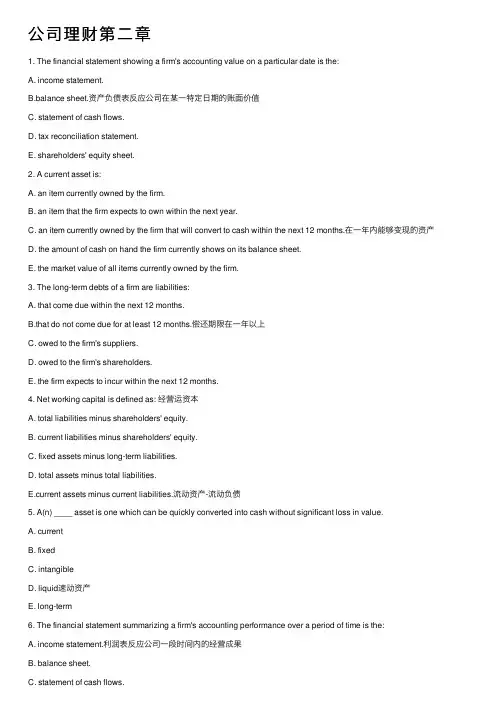
公司理财第⼆章1. The financial statement showing a firm's accounting value on a particular date is the:A. income statement.B.balance sheet.资产负债表反应公司在某⼀特定⽇期的账⾯价值C. statement of cash flows.D. tax reconciliation statement.E. shareholders' equity sheet.2. A current asset is:A. an item currently owned by the firm.B. an item that the firm expects to own within the next year.C. an item currently owned by the firm that will convert to cash within the next 12 months.在⼀年内能够变现的资产D. the amount of cash on hand the firm currently shows on its balance sheet.E. the market value of all items currently owned by the firm.3. The long-term debts of a firm are liabilities:A. that come due within the next 12 months.B.that do not come due for at least 12 months.偿还期限在⼀年以上C. owed to the firm's suppliers.D. owed to the firm's shareholders.E. the firm expects to incur within the next 12 months.4. Net working capital is defined as: 经营运资本A. total liabilities minus shareholders' equity.B. current liabilities minus shareholders' equity.C. fixed assets minus long-term liabilities.D. total assets minus total liabilities.E.current assets minus current liabilities.流动资产-流动负债5. A(n) ____ asset is one which can be quickly converted into cash without significant loss in value.A. currentB. fixedC. intangibleD. liquid速动资产E. long-term6. The financial statement summarizing a firm's accounting performance over a period of time is the:A. income statement.利润表反应公司⼀段时间内的经营成果B. balance sheet.C. statement of cash flows.D. tax reconciliation statement.E. shareholders' equity sheet. 7. Noncash items refer to: ⾮现⾦项⽬A. the credit sales of a firm.B. the accounts payable of a firm.C. the costs incurred for the purchase of intangible fixed assets.D. expenses charged against revenues that do not directly affect cash flow.与收⼊像配⽐的费⽤,并不影响现⾦流量E. all accounts on the balance sheet other than cash on hand.8. Your _____ tax rate is the amount of tax payable on the next taxable dollar you earn.A. deductibleB. residualC. totalD. averageE. marginal边际税率指多赚⼀美元需要多⽀付的税⾦9. Your _____ tax rate is the total taxes you pay divided by your taxable income.A. deductibleB. residualC. totalD.average平均税率E. marginal10. _____ refers to the cash flow that results from the firm's ongoing, normal business activities.A.Cash flow from operating activities经营活动现⾦流B. Capital spendingC. Net working capitalD. Cash flow from assetsE. Cash flow to creditors11. _____ refers to the changes in net capital assets.A. Operating cash flowB. Cash flow from investing投资活动产⽣的现⾦流C. Net working capitalD. Cash flow from assetsE. Cash flow to creditors12. _____ refers to the difference between a firm's current assets and its current liabilities.A. Operating cash flowB. Capital spending/doc/2c11347143.htmlworking capital净营运资本是流动资产与流动负债之差D. Cash flow from assetsE. Cash flow to creditors13. _____ is calculated by adding back noncash expenses to net income and adjusting for changes in current assets and liabilities. ⾮现⾦费⽤加净利润,根据流动资产和流动负债的变化做出调整A. Operating cash flowB. Capital spendingC. Net working capitalD.Cash flow from operation s经营活动产⽣的现⾦流E. Cash flow to creditors14. _____ refers to the firm's interest payments less any net new borrowing.A. Operating cash flowB. Capital spendingC. Net working capitalD. Cash flow from shareholdersE.Cash flow to creditors向债权⼈⽀付的现⾦流=⽀付的利息—净新借⼊额15. _____ refers to the firm's dividend payments less any net new equity raised.A. Operating cash flowB. Capital spendingC. Net working capitalD. Cash flow from creditorsE.Cash flow to stockholder s向股东⽀付的现⾦流=⽀付的股利—权益筹资净额16. Earnings per share is equal to: 每股收益A. net income divided by the total number of shares outstanding.净利润/流通在外的股数B. net income divided by the par value of the common stock.C. gross income multiplied by the par value of the common stock.D. operating income divided by the par value of the common stock.E. net income divided by total shareholders' equity.17. Dividends per share is equal to dividends paid: 每股股利A. divided by the par value of common stock.B.divided by the total number of shares outstanding.股利/流通在外的股数C. divided by total shareholders' equity.D. multiplied by the par value of the common stock.E. multiplied by the total number of shares outstanding.18. Which of the following are included in current assets?I. equipment设备II. Inventory存货III. accounts payable应付账款IV. cash 现⾦A. II and IV onlyB. I and III onlyC. I, II, and IV onlyD. III and IV onlyE. II, III, and IV only 19. Which of the following are included in current liabilities?I. note payable to a supplier in eighteen months应付票据II. debt payable to a mortgage company in nine months短期负债III. accounts payable to suppliers应付账款IV. loan payable to the bank in fourteen months 长期负债A. I and III onlyB. II and III onlyC. III and IV onlyD. II, III, and IV onlyE. I, II, and III only20. An increase in total assets:A. means that net working capital is also increasing.B. requires an investment in fixed assets.C. means that shareholders' equity must also increase.D.must be offset by an equal increase in liabilities and shareholders' equity.总资产的增加必定对应相应负债和所有者权益的增加E. can only occur when a firm has positive net income.21. Which one of the following assets is generally the most liquid?A. inventoryB. buildingsC.accounts receivable应收账款D. equipmentE. patents22. Which one of the following statements concerning liquidity is correct?A. If you sold an asset today, it was a liquid asset.B. If you can sell an asset next year at a price equal to its actual value, the asset is highly liquid.C. Trademarks and patents are highly liquid.D. The less liquidity a firm has, the lower the probability the firm will encounter financial difficulties.E.Balance sheet accounts are listed in order of decreasing liquidity.资产负债表账户是按流动性减弱排序的23. Liquidity is:A. a measure of the use of debt in a firm's capital structure.B. equal to current assets minus current liabilities.C. equal to the market value of a firm's total assets minus its current liabilities.D. v aluable to a firm even though liquid assets tend to be less profitable to own.在不引起价值⼤幅损失的前提下,资产变现的⽅便与快捷成度E. generally associated with intangible assets.24. Which of the following accounts are included in shareholders' equity?I. interest paid利息费⽤II. retained earnings留存收益III. capital surplus资本盈余IV. long-term debt 长期负债A. I and II onlyB. II and IV onlyC. I and IV onlyD. II and III onlyE. I and III only25. Book value: 账⾯价值A. is equivalent to market value for firms with fixed assets.B. is based on historical cost.基于历史成本C. generally tends to exceed market value when fixed assets are included.D. is more of a financial than an accounting valuation.E. is adjusted to market value whenever the market value exceeds the stated book value.26. When making financial decisions related to assets, you should:A. always consider market values.考虑市场价值B. place more emphasis on book values than on market values.C. rely primarily on the value of assets as shown on the balance sheet.D. place primary emphasis on historical costs.E. only consider market values if they are less than book values.27. As seen on an income statement:A. interest is deducted from income and increases the total taxes incurred.B. the tax rate is applied to the earnings before interest and taxes when the firm has both depreciation and interest expenses.C. depreciation is shown as an expense but does not affect the taxes payable.D. depreciation reduces both the pretax income and the net income.折旧会降低息税前利润和净利润E. interest expense is added to earnings before interest and taxes to get pretax income.28. The earnings per share will:A. increase as net income increases.B. increase as the number of shares outstanding increase.C. decrease as the total revenue of the firm increases.D. increase as the tax rate increases.E. decrease as the costs decrease. 29. Dividends per share: 每股股利A. increase as the net income increases as long as the number of shares outstanding remains constant.B. decrease as the number of shares outstanding decrease, all else constant.C. are inversely related to the earnings per share.D. are based upon the dividend requirements established by Generally Accepted Accounting Procedures.E. are equal to the amount of net income distributed to shareholders divided by the number of shares outstanding.30. Earnings per share 每股收益=净收⼊/流通在外股数A.will increase if net income increases and number of shares remains constant.不变B. will increase if net income decreases and number of shares remains constant.C. is number of shares divided by net income.D. is the amount of money that goes into retained earnings on a per share basis.E. None of the above.31. According to Generally Accepted Accounting Principles, costs are:A. recorded as incurred.B. recorded when paid.C. matched with revenues.资产应按成本计价D. matched with production levels.E. expensed as management desires.32. Depreciation:A. is a noncash expense that is recorded on the income statement.⾮现⾦项⽬B. increases the net fixed assets as shown on the balance sheet.C. reduces both the net fixed assets and the costs of a firm.D. is a non-cash expense which increases the net operating income.E. decreases net fixed assets, net income, and operating cash flows.33. When you are making a financial decision, the most relevant重要的,有意义的 tax rate is the _____ rate.A. averageB. fixedC. marginal边际税率D. totalE. variable34. An increase in which one of the following will cause the operating cash flow to increase?A. depreciation折旧B. changes in the amount of net fixed capitalC. net working capitalD. taxesE. costs35. A firm starts its year with a positive net working capital. During the year, the firm acquires more short-term debt than it does short-term assets. This means that:A. the ending net working capital will be negative.B. both accounts receivable and inventory decreased during the year.C. the beginning current assets were less than the beginning current liabilities.D. accounts payable increased and inventory decreased during the year.E. the ending net working capital can be positive, negative, or equal to zero.36. The cash flow to creditors includes the cash:A. received by the firm when payments are paid to suppliers.B. outflow of the firm when new debt is acquired.C. outflow when interest is paid on outstanding debt.D. inflow when accounts payable decreases.E. received when long-term debt is paid off.37. Cash flow to stockholders must be positive when:A. the dividends paid exceed(超过) the net new equity raised.B. the net sale of common stock exceeds the amount of dividends paid.C. no income is distributed but new shares of stock are sold.D. both the cash flow to assets and the cash flow to creditors are negative.E. both the cash flow to assets and the cash flow to creditors are positive.38. Which equality is the basis for the balance sheet?A. Fixed Assets = Stockholder's Equity + Current AssetsB. Assets = Liabilities + Stockholder's EquityC. Assets = Current Long-Term Debt + Retained EarningsD. Fixed Assets = Liabilities + Stockholder's EquityE. None of the above39. Assets are listed on the balance sheet in order of:A. decreasing liquidity.流动性减弱B. decreasing size.C. increasing size.D. relative life.E. None of the above. 40. Debt is a contractual obligation(契约责任) that:A. requires the payout of residual flows to the holders of these instruments.B. requires a repayment of a stated amount and interest over the period.⽀付固定利息C. allows the bondholders to sue the firm if it defaults不履⾏.当公司不履⾏债务时债权⼈可以请求偿还D. Both A and B.E. Both B and C.41. The carrying value or book value of assets:A. is determined under GAAP and is based on the cost of the asset.基于历史成本B. represents the true market value according to GAAP.C. is always the best measure of the company's value to an investor.D. is always higher than the replacement cost of the assets.E. None of the above.42. Under GAAP, a firm's assets are reported at:A. market value.B. liquidation value.C. intrinsic value.D. cost.E. None of the above.43. Which of the following statements concerning the income statement is true?A. It measures performance over a specific period of time.⼀段时间的经营成果B. It determines after-tax income of the firm.决定公司税后利润C. It includes deferred taxes.递延税D. It treats interest as an expense.把利息视做费⽤E. All of the above.44. According to generally accepted accounting principles (GAAP), revenue is recognized as income when:A. a contract is signed to perform a service or deliver a good.B. the transaction is complete and the goods or services are delivere d.实现收⼊C. payment is requested.D. income taxes are paid.E. All of the above.45. Which of the following is not included in the computation 估算 of operating cash flow?A. Earnings before interest and taxesB. Interest paid利息⽀付C. DepreciationD. Current taxesE. All of the above are included46. Net capital spending is equal to: 资本性⽀出=固定资产出售-固定资产取得A. net additions to net working capital.B. the net change in fixed assets.C. net income plus depreciation.D. total cash flow to stockholders less interest and dividends paid.E. the change in total assets.47. Cash flow to stockholders is defined as:A. interest payments.B. repurchases of equity less cash dividends paid plus new equity sold.C. cash flow from financing less cash flow to creditors.D. cash dividends plus repurchases of equity minus new equity financing.E. None of the above.48. Free cash flow is: ⾃由现⾦流A. without cost to the firm.B. net income plus taxes.C. an increase in net working capital.D. cash that the firm is free to distribute to creditors and stockholders.现⾦可以⾃由的分配给债权⼈和股东E. None of the above.49. The cash flow of the firm must be equal to:A. cash flow to stockholders minus cash flow to debtholders.B. cash flow to debtholders minus cash flow to stockholders.C. cash flow to governments plus cash flow to stockholders.D. cash flow to stockholders plus cash flow to debtholders.E. None of the above.50. Which of the following are all components 组成of the statement of cash flows?A. Cash flow from operating activities, cash flow from investing activities, and cash flow from financing activities经营活动,投资活动,筹资活动B. Cash flow from operating activities, cash flow from investing activities, and cash flow from divesting activitiesC. Cash flow from internal activities, cash flow from external activities, and cash flow from financing activitiesD. Cash flow from brokering activities, cash flow from profitable activities, and cash flow from non-profitable activitiesE. None of the above.51. One of the reasons why cash flow analysis is popular is because:A. cash flows are more subjective than net income.B. cash flows are hard to understand.C. it is easy to manipulate, or spin the cash flows.D. it is difficult to manipulate, or spin the cash flows.现⾦流很难编造和篡改E. None of the above. 52 A firm has $300 in inventory, $600 in fixed assets, $200 in accounts receivable, $100 in accounts payable, and $50 in cash. What is the amount of the current assets?A. $500B. $550C. $600D. $1,150E. $1,200Current assets = $300 + $200 + $50 = $55053. Total assets are $900, fixed assets are $600, long-term debt is $500, and short-term debt is $200. What is the amount of net working capital?A. $0B. $100C. $200D. $300E. $400Net working capital = $900 - $600 - $200 = $10054. Brad's Company has equipment with a book value of $500 that could be sold today at a 50% discount. Its inventory is valued at $400 and could be sold to a competitor for that amount. The firm has $50 in cash and customers owe it $300. What is the accounting value of its liquid assets?A. $50B. $350C. $700D. $750E. $1,000Liquid assets = $400 + $50 + $300 = $75055. Martha's Enterprises spent $2,400 to purchase equipment three years ago. This equipment is currently valued at $1,800 on today's balance sheet but could actually be sold for $2,000. Net working capital is $200 and long-term debt is $800. Assuming the equipment is the firm's only fixed asset, what is the book value of shareholders' equity?A. $200B. $800C. $1,200D. $1,400E. The answer cannot be determined from the information providedBook value of shareholders' equity = $1,800 + $200 - $800 = $1,20056. Art's Boutique has sales of $640,000 and costs of $480,000. Interest expense is $40,000 and depreciation is $60,000. The tax rate is 34%. What is the net income?A. $20,400B. $39,600C. $50,400D. $79,600E. $99,600Taxable income = $640,000 - $480,000 - $40,000 - $60,000 = $60,000; Tax = .34($60,000) = $20,400; Net income = $60,000 - $20,400 = $39,60057. Given the tax rates as shown, what is the average tax rate for a firm with taxable income of $126,500?A. 21.38%B. 23.88%C.25.76%应纳税额/应税所得D. 34.64%E. 39.00%Tax = .15($50,000) + .25($25,000) + .34($25,000)+ .39($126,500 - $100,000) = $32,585; Average tax rate = $32,585 ÷ $126,500 = .2576 = 25.76%58. The tax rates are as shown. Your firm currently has taxable income of $79,400. How much additional tax will you owe if you increase your taxable income by $21,000?A. $7,004B. $7,014C. $7,140D. $7,160E. $7,174Additional tax = .34($100,000 - $79,400) + .39($79,400 + $21,000 - $100,000) = $7,160 59. Your firm has net income of $198 on total sales of $1,200. Costs are $715 and depreciation is $145. The tax rate is 34%. The firm does not have interest expenses. What is the operating cash flow?A. $93B. $241C. $340D. $383E. $485Earnings before interest and taxes = $1,200 - $715 - $145 = $340; Tax = [$198 ÷ (1 - .34)] - $198 = $102; Operating cash flow = $340 + $145 - $102 = $383经营性现⾦流=息税前利润-折旧+所得税60. Teddy's Pillows has beginning net fixed assets of $480 and ending net fixed assets of $530. Assets valued at $300 were sold during the year. Depreciation was $40. What is the amount of capital spending?A. $10B. $50C. $90D. $260E. $390Net capital spending = $530 - $480 + $40 = $90资本性⽀出=期末固定资产净值-期初固定资产净值+折旧61. At the beginning of the year, a firm has current assets of $380 and current liabilities of $210. At the end of the year, the current assets are $410 and the current liabilities are $250. What is the change in net working capital?C. $0D. $10E. $30Change in net working capital = ($410 - $250) - ($380 - $210) = -$1062. At the beginning of the year, long-term debt of a firm is $280 and total debt is $340. At the end of the year, long-term debt is $260 and total debt is $350. The interest paid is $30. What is the amount of the cash flow to creditors?A. -$50B. -$20C. $20D. $30E. $50Cash flow to creditors = $30 - ($260 - $280) = $5063. Pete's Boats has beginning long-term debt of $180 and ending long-term debt of $210. The beginning and ending total debt balances are $340 and $360, respectively. The interest paid is $20. What is the amount of the cash flow to creditors? A. -$10 B. $0 C. $10 D. $40 E. $50Cash flow to creditors = $20 - ($210 - $180) = -$1064. Peggy Grey's Cookies has net income of $360. The firm pays out 40% of the net income to its shareholders as dividends. During the year, the company sold $80 worth of common stock. What is the cash flow to stockholders? A. $64 B. $136 C. $144 D. $224 E. $296Cash flow to stockholders = .40($360) - $80 = $6465. Thompson's Jet Skis has operating cash flow of $218. Depreciation is $45 and interest paid is $35. A net total of $69 was paid on long-term debt. The firm spent $180 on fixed assets and increased net working capital by $38. What is the amount of the cash flow to stockholders? A. -$104 B. -$28 C. $28 D. $114 E. $142Cash flow of the firm = $218 - $38 - $180 = $0; Cash flow to creditors = $35 - (-$69) = $104; Cash flow to stockholders =$0 - $104 = -$10466. What is the change in the net working capital from 2007 to 2008? A. $1,235 B. $1,035 C. $1,335 D. $3,405 E. $4,740 Change in net working capital = ($7,310 - $2,570) - ($6,225 - $2,820) = $1,33567. What is the amount of the non-cash expenses for 2008? A. $570 B. $630 C. $845 D. $1,370 E. $2,000The non-cash expense is depreciation in the amount of $1,370. 68. What is the amount of the net capital spending for 2008?A. -$290B. $795C. $1,080D. $1,660E. $2,165Net capital spending = $10,670 - $10,960 + $1,370 = $1,080 69. What is the operating cash flow for 2008? A. $845 B. $1,930 C. $2,215 D. $2,845 E. $3,060Operating cash flow = $1,930 + $1,370 - $455 = $2,84570. What is the cash flow of the firm for 2008?A. $430E. $3,100Operating cash flow = $1,930 + $1,370 - $455 = $2,845; Change in net working capital = ($7,310 - $2,570) - ($6,225 - $2,820) = $1,335; Net capital spending = $10,670 - $10,960 + $1,370 = $1,080; Cash flow of the firm = $2,845 - $1,335 - $1,080 = $43071. What is the amount of net new borrowing for 2008?A. -$225B. -$25C. $0D. $25E. $225Net new borrowing = $8,100 - $7,875 = $22572. What is the cash flow to creditors for 2008?A. -$405B. -$225C. $225D. $405E. $630Cash flow to creditors = $630 - ($8,100 - $7,875) = $40573. What is the net working capital for 2008?A. $345B. $405C. $805D. $812E. $1,005 Net working capital = $75 + $502 + $640 - $405 = $812 74. What is the change in net working capital from 2007 to 2008?A. -$93B. -$7C. $7D. $85E. $97Change in net working capital = ($75 + $502 + $640 - $405) - ($70 + $563 + $662 - $390) = -$9375. What is net capital spending for 2008?A. -$250E. $477Net capital spending = $1,413 - $1,680 + $210 = -$5776. What is the operating cash flow for 2008?A. $143B. $297C. $325D. $353E. $367Earnings before interest and taxes = $785 - $460 - $210 = $115; Taxable income = $115 - $35 = $80; Taxes = .35($80) = $28; Operating cash flow = $115 + $210 - $28 = $29777. What is the cash flow of the firm for 2008?A. $50B. $247C. $297D. $447E. $517Cash flow of the firm = $297 - (-$93) - (-$57) = $447 (See problems 74 and 75)78. What is net new borrowing for 2008?A. -$70B. -$35C. $35D. $70E. $105Net new borrowing = $410 - $340 = $7079. What is the cash flow to creditors for 2008?A. -$170B. -$35C. $135D. $170E. $205Cash flow to creditors = $35 - ($410 - $340) = -$3580. What is the cash flow to stockholders for 2008?A. $408E. $503Cash flow to stockholders = $447 - (-$35) = $482 (See problems 77 and 79); or, Cash flow to stockholders = $17 - ($235 -$700) = $48281. What is the taxable income for 2008?A. $360B. $520C. $640D. $780E. $800Net income = $160 + $360 = $520; Taxable income = $520 (1 - .35) = $80082. What is the operating cash flow for 2008?A. $520B. $800C. $1,015D. $1,110E. $1,390Earnings before interest and taxes = $800 + $215 = $1,015 (See problem 81); Operating cash flow = $1,015 + $375 - ($800 -$520) = $1,110 (See problem 81)83. What are the sales for 2008?A. $4,225B. $4,385C. $4,600D. $4,815E. $5,000Sales = $1,015 + $375 + $3,210 = $4,600 (see problem 82) 84. Calculate net income based on the following information. Sales are $250, cost of goods sold is $160, depreciation expense is $35, interest paid is $20, and the tax rate is 34%.A. $11.90B. $23.10C. $35.00D. $36.30E. $46.20((Sales - COGS) - Depreciation - Interest) - Taxes = Net Income (($250 - $160) - $35 - $20) - $11.9 = $23.10。